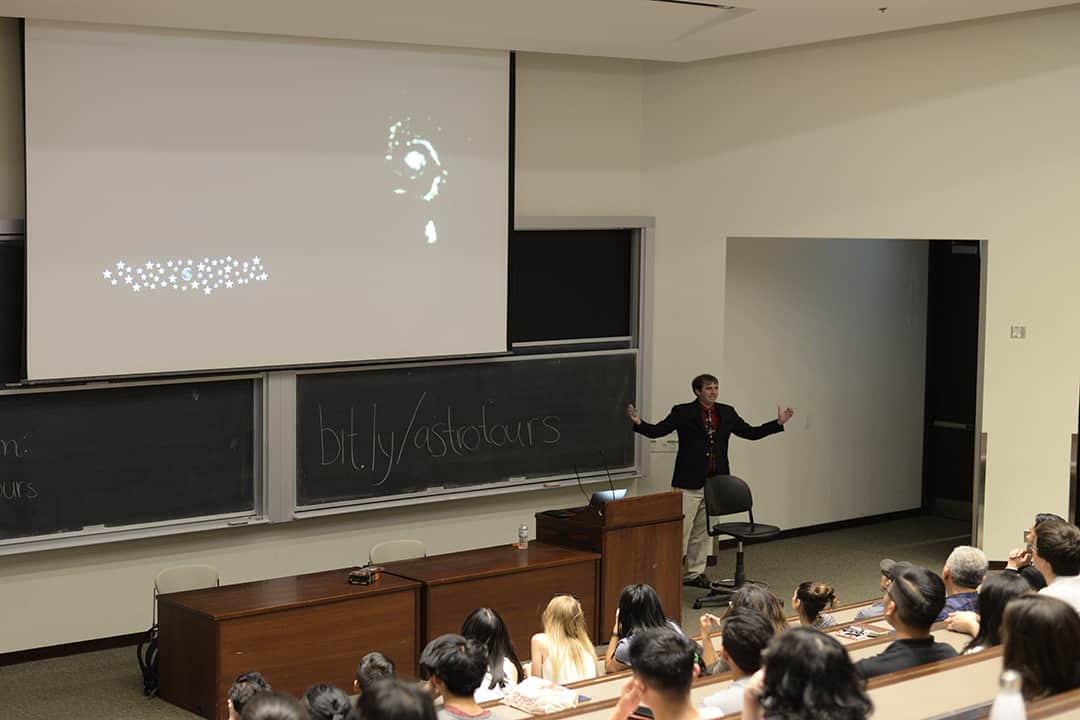Dr. Patrick Breysse, a postdoctoral researcher at the Canadian Institute for Theoretical Astrophysics, dragged our minds back in time, painted a picture of the universe, and explained how laughably inadequate the term “Big Bang” is at capturing the birth of our reality, in a public talk delivered at U of T on August 1.
How early conceptions of the universe evolved over time
The talk, titled “A Brief History of Everything,” was attended by around 300 audience members at the Bahen Centre for Information Technology. Breysse opened with an introduction to the works of American astronomers Henrietta Swan Leavitt and Edwin Hubble in the early 1900s.
At that time, philosophers believed that the Milky Way was at the centre of the universe and was surrounded by a sea of unchanging, unmoving stars. But the discovery of massive swirling clouds called spiral nebulae threw a wrench in that model.
“There was a great debate around [1908 about] whether these were little gas clouds in our galaxy or enormous things outside of it,” explained Breysse.
Leavitt noticed the blinking of special stars called Cepheid variables, and she figured out that the speed of this blinking could tell us how bright the star is. Hubble used this to figure out how far bright stars are. The giant cluster of stars they quantified eventually became known as the modern galaxies.
Hubble also showed that these clusters of stars are separate from the Milky Way. The closest galaxy to us, Andromeda, is a whopping 24 quintillion kilometres away — that’s eighteen zeros!
“If I say Andromeda is as far as the moon is away from us, as the moon is from the earth, then the earth would have to be the size of a virus,” noted Breysse.
Hubble concluded that everything in the universe was moving away from us, and so there must have been a point when everything was together, and that an explosion resulted in this scattering of matter.
Decades of investigation later, we know that we are not at the centre of the universe, but are instead surrounded by massive constellations of massive galaxies and cosmic phenomena.
“Astronomy is, if anything, good for telling you, you are not special in any comprehensive way!”
How theoretical physics underpins our current understanding
From the centre-of-the-universe conception, Breysse brought us up to date with the Lambda Cold Dark Matter model of the universe. This model is, in essence, the Big Bang Theory – the universe started out in a “hot dense state, and then nearly 14 billion years ago,” something happened and here we are.
Astronomers study the origin of the universe by constructing images of cosmic webs of matter and empty space using powerful telescopes and satellites. These researchers glean knowledge from ergo-planetary discs, and learn about the birth of galaxies from nebulae.
Despite all this, there is a two-billion-year gap in our knowledge. Breysse and his research team use microwaves and intensity mappings to construct an idea of what our cosmic past might have looked like – the universe’s “baby pictures.”
“Every telescope is secretly a time machine,” said Breysse. “Telescopes look at light, and light travels at a constant speed.”
As light travels at nearly 300,000 kilometres per second, images captured from the distant reaches of the universe represent moments taken from the past. This is accounted for by the time it takes for the light to reach our instruments.
The further out we take observations from, the closer we get to the moment the universe originated.
Reactions from audience members
Audience members were given the opportunity to ask questions and express their appreciation at the end of the evening.
“It was a fun and informative talk. He made a topic that’s quite difficult to understand simple, and did it in an entertaining way,” said Maeesha Mahbub, a third-year Fundamental Genetics and its Applications specialist, to The Varsity.
The audience was also, surprisingly, filled with children from the neighbouring communities accompanied by their families. One brave nine-year-old, Leffe Monette, enthusiastically asked Breysse questions during the talk.
“I really enjoyed the talk! I liked how he showed us how far the other galaxies are,” said Leffe, a student of St. Michael’s College School. “I want to be a [space] scientist!”
Following the talk, audience members were given the chance to view Saturn and Jupiter through telescopes from U of T’s Department of Astronomy and Astrophysics atop McLennan Physical Libraries.
AstroTours also set up a free planetarium show for audience members following Breysse’s talk, conveying further information on the vast expanse of the universe to interested attendees.


